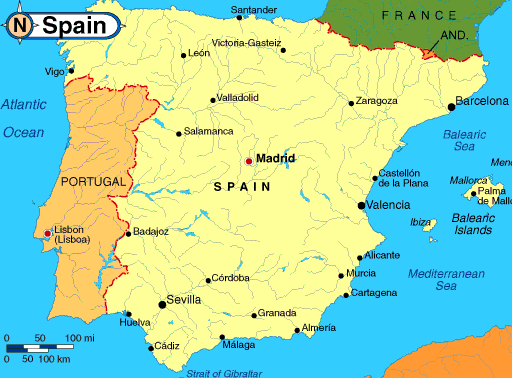Personnel numbers- Overall, the Spanish military maintains one of the highest civilian to military personnel ratios in Europe. Spain's military has over 500,000 soldiers serving in the active military, and 200,000 in reserves. Meaning, overall, Spain enlists a whooping 720,000 (roughly) people into its armed forces. This fact can be attributed to the exponential rise in nationalism after the ending of the third of the World Wars. Combine this with the Spanish people's insecurity caused by the recent rise of authoritarian governments and rumors of terrorist threats within Spain's borders, and you have the perfect cocktail for the beginnings of a militarily focused nation.
Army: 315,000
Navy: 200,000 - 134,000 of these troops belong to the Spanish Marine Corps, a subsidiary of the Spanish Navy
Air Force: 70,000 - 35,000 of these troops belong to the Airborne Corps, a subsidiary of the Spanish Air Force
Imperial Guard: 100,000
Special Forces: 5,000
Equipment- The Spanish military boasts an abnormally high military budget. Where does most of that money go? Research. Spain claims to be on the razor's edge of military research in the areas of personal body armor. You see, Spanish scientist Fernando Arteta discovered a means of mass producing spider silk. By combining the DNA of a common goat and the Golden Orb spider, Arteta was able to birth a goat with the ability to produce spider silk instead of milk. Hundreds of thousands of these goats were created, and the cross breeding of species was perfected to the point where entire spider silk goat farms have been built. This spider silk has replaced kevlar within the Spanish military; aside from being ultralight and flexible, pound for pound the silk is ten times as strong as kevlar. The Spaniards have done away with ceramic plates and instead chosen to replace them with ballistic foams of their own design.
The perfect compliment for Spain's patented advanced armor? Soft exosuits.
Designed by the Americans, the Spanish bought the exosuits in bulk back in 2040. These suits come equipped with a number of different features, including: enhanced strength and agility, jump packs, grappling hooks, and a battery powerful enough to last a full week. The suit is lightweight and can be folded up to fit inside a briefcase or backpack.
The Spanish infantry's loadout is rounded out with the most important piece of technology Spain has developed in years: the medical gauntlet. A piece of machinery designed to fit around the wrist, the medi-gauntlet functions as a medkit and emergency field dress device simple enough for anyone to use with only basic training required. The gauntlet contains tiny spouts that shoot microscopic jets of water into the skin. Inside this water is contained a number of chemicals which act as a pain reliever, as well as temporarily speeding up one's natural healing factor. When a soldier is wounded, they only have to press a button on the gauntlet and they'll receive a powerful shot of morphine, and their body will begin to clot the wound at a rapid pace. The gauntlet can also be used to administer a medical foam, which plugs up wounds artificially to prevent extensive blood loss.
The modern Spanish soldier is equipped with a soft exosuit, a suit of full body spider silk armor alongside state of the art ballistic foam plates, and medi-gauntlets. Said loadout is enhanced by holo-finders within the helmets, which give the soldier a heads up display linked back to their base of operations. The holo-finder can also be linked up to a soldier's firearm to enhance one's aim. This is especially useful for snipers, who come equipped with a modified holo-finder as standard gear.
Aside from infantry technology, Spain lacks much to set it apart from the rest of the European Union. They use standard Main Battle Tanks as the backbone of the armored portion of their forces. Railguns have become the standard means of delivering artillery, on the ground and at sea. In the air the Spanish Empire mostly relies on old 5th generation fighter tech, and are only experimenting with energy weapons, lasers, and railguns on their fighters. They lack many combat drones, although they do possess a number of aerial reconnaissance drones that utilize stealth technologies common to Western air forces.
Equipment numbers-Main Battle Tanks: 1750
Light Armored Vehicles: 3400
Fighter/Bombers: 735
Frigates: 19
Destroyers: 30
Aircraft Carriers: 2
Battleships: 1
Submarines: 15
Notable Leadership-Emperor Banos I, as the monarch of the Spanish Empire, acts as the commander in chief and thus has executive authority within the military.
General Zayas: Commands the 1th Spanish Brigade
General Taboada: Commands the 5th Air Force
Admiral Morillo: Commands the 2nd Fleet, Chief of Defense Staff
Brigadier General Custa: Commands the 41st Airborne
Commander Alvarez: Commands the 6th Imperial Guard
Colonel Alava: Commands the 1st Special Operations Forces, Chief of Espionage
These men and women are all members of the Defense Staff, who advise the Emperor on military actions and defense against foreign powers.
Non-Aggression Pacts:N/A
Military alliances: N/A
Enemies of the State: N/A








